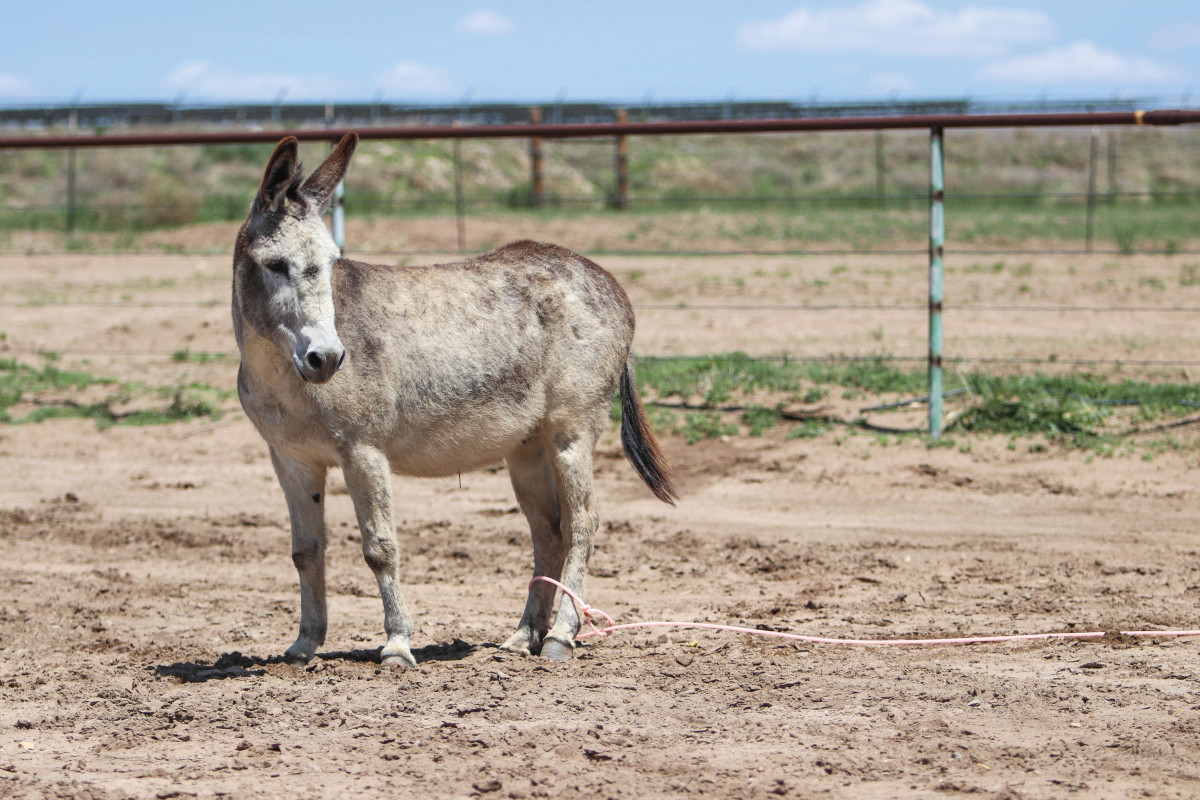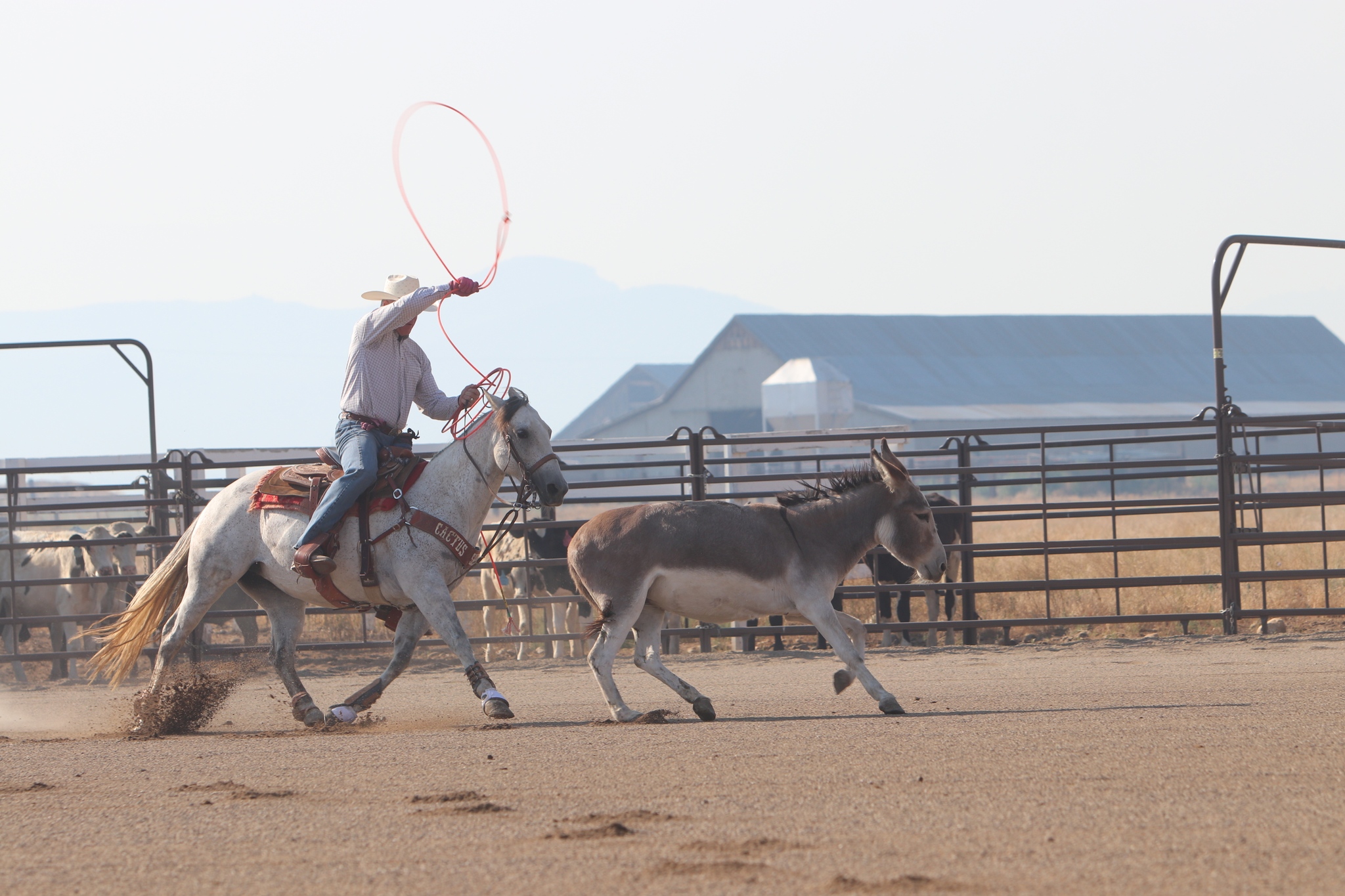Always wanted a ground-driven trainer?
Did you know there’s one out there that’s self-propelled? That doesn’t hard-pack your nice, fluffy arena dirt? That lets you practice without needing another single soul to drive?
Here’s the icing on the cake—it has a built-in mechanism to help your horse rate off. “Equus asinus” is the long-kept secret of several of America’s world champs and top rope-horse trainers. Practicing on “asses” is good for timing, good for horses and good for time management.
Once the preferred transportation of Jesus Christ, the donkey has been in America since the 16 century—brought here by the Spanish, whose name for “donkey” is “burro.” While the Prince of Peace never expected his ride to be heeled by two feet, ropers today rave about practicing on burros.

The defending world champion heeler, in fact, wouldn’t take any amount of money for Francis, his donkey. Paul Eaves grew up in Missouri roping a lead steer and goats before being introduced to donkeys when four-time world champion Allen Bach had one.
“I’d been looking for one like his ever since,” said Eaves. “I got a few that didn’t really work, but this one I have now is awesome. He gets treated like my best horses.”
Donkeys helped Eaves become the best heeler in the world thanks to being real. They’re alive; they have a real hop.
“If there’s something I really need to do with my horses, the Smarty can be better, but there are other things I’ll need to do, practicing, when something live is better,” he said. “I really couldn’t get along without Smarty and Francis, both.”
A donkey is arguably the best tool for starting young, green rope horses, but it’s also great for quieting down older horses.
“Brady Minor left Rey with me for about 10 days while he went to Ellensburg, so I could rope the donkey on him and kind of get him out of ‘rodeo mode,’” said Willy Gould, 45, a full-time horse trainer out of Wickenburg, Arizona, and Meeteetse, Wyoming.
If even the two-time AQHA/PRCA Heel Horse of the Year benefits from a little burro action, it seems to be a no-brainer. Gould, a 7.5 heeler, first roped a burro owned by his college rodeo coach, Danny Cross, in the 1990s. While in college, he trained his own yearling jack (male donkey) and hasn’t been without a burro ever since.
“I roped that first one for 23 years,” said Gould, who called him Jasper and named all his others after the Lonesome Dove miniseries, as well. “He was as good as gold. I wouldn’t have taken any amount of money for him. If you walked, he walked; if you trotted; he trotted, and if you went fast, he went fast. Plus, I could rope him anywhere—out in front of the box or in a corner. If I moved to the right, he would go left across the pen, and the same thing down the other side.”
Family members
Donkeys are more laid back and self preserving than horses, and have great memories, although they can be ornery to dogs. They’re trainable on voice commands and can recognize other donkeys they haven’t seen for 25 years. What’s more, they can live up to age 40 and only need up to 6 pounds of daily hay. Most trainers keep them with their roping steers.
Like Gould, trainer Zane Bruce of Mineral Wells, Texas, roped his first burro, Charlie, in college—although his was on a pivot, rather than loose.
“My parents bought that donkey and my dad is a welder, so he built a wheel and an arm,” recalled Bruce. “We’d just attach his halter to the arm and ’round and ’round you go.”
Charlie has since taught grandchildren to rope, and has been in the Bruce family nearing on 30 years now. That’s a long return on a cheap investment. You can find a burro to purchase possibly on Craigslist, or at monthly livestock auctions. Trainer Jason Thomas of Canyon, Texas, has even gotten some free when the government just needed some feral donkeys caught.
Thomas, an 8 heeler out of Canyon, Texas, used to train and sell roping burros for $700 to $1,000 while keeping eight to 10 of his own. The two he currently ropes are Pepe and Nacho Libre. His system is first to halter-break one, then break it to lead and start roping it. He thinks a jenny is easier to train than a jack and not as apt to kick in the early days. Of course, that can be the advantage, too, of practicing on a burro.
“On colts that don’t know how to rate, if you get too close, the donkey will kick the colt and he’ll start paying attention pretty fast,” Thomas said.
Methods to the madness
There are pros and cons of the various methods of donkey practice, and Thomas prefers using a pivot because it gives him a consistent circle. He’s made his own free-swinging pivots by cutting an axle in half and burying it so the hub is sticking up, and adding an arm and counterweight. He teaches his donkeys to take off at his whistle.
“I usually warm up all my horses on the donkey,” said Thomas. “They have to stay in the left lead, have to rate and everything else. I throw some loops and get my horse locked in and tracking. Or if I’m by myself, those two donkeys and I can get through six or seven horses, throwing 15-20 loops per horse.”
Meanwhile, Gould trains his loose donkey on a pattern like a lead steer, using a grain bucket at first, and teaches it to take off when he clucks to it. Jose, his current donkey, was used on a pivot with former owner Bobby Mote, and makes that same circle now, loose. Or, as four-time NFR team roper George Aros was known to do, you can have a header log the donkey as the heeler tracks him around. This is also the way Eaves prefers to do it.
“The header doesn’t even have to dally,” Eaves said. “Once the heeler gets up there and starts swinging, the donkey just starts turning and you can track him across the arena.”
Eaves said Francis can almost make that same run by himself, so he ropes him loose, too. He’s careful not to put more than about 15 total runs on him a day, at which point Francis gets extra alfalfa and grain, and is otherwise turned out on grass.
“A local AQHA Hall-of-Famer, Mike Drennan, got me to doing it,” said former NFR heeler Nick Sarchett of Phoenix. “He had seven or eight donkeys and thought they were the best tool in the world. I learned a lot, working for him, and it was phenomenal for those colts. Burros are easy to train and just go forever. It teaches colts to rate without you having to pull on them all the time, because they respect their distance once they get kicked in the chest for over-running the donkey.”
Thomas figures he ropes burros as often as he does live steers.
“I do all kinds of drills,” he said. “You can hold your position like you would on a steer, or lope on the outside and then let your horse come into the turn. I lope tight circles out beside the donkey and engage and come in to the donkey, which teaches a horse to gather its stride.”

Gold-buckle burro
Nobody ever dallies on a donkey. Thomas simply holds his rope up and continues following the donkey or stops his horse. The only time Thomas’ donkeys feel a tug on the rope is if they kick. Bruce remembers Charlie would kick the rope back to him after a run, then just stand there and wait for him to rebuild and start swinging before taking off again.
Like the other donkey fans out there, Bruce feels their best attribute is living and breathing.
“I think it takes longer for a colt to get used to a live steer on the end of the rope if he hasn’t roped a donkey first,” Bruce said. “Sleds get the horse patterned, but he’s still not used to anything live back there, moving.”
That kind of natural timing means everything to Gould, who can never throw enough loops at a donkey, and talks about the confidence they give you before a roping. Thomas sees the effect in the horses he’s training on his high-loping donkey and his slower-loping one.
“You’re roping a live animal, so your horse is watching and learning to rate and get in time,” he said.
Sarchett loves a donkey for horse-training, but feels like a donkey hop is too easy to help him sharpen up his own roping; the feet are too close together and forgiving of “cruddy” loops. Eaves, on the other hand, says the opposite.
“Sometimes you feel like you can cheat on, say, an old practice steer,” Eaves said. “But you can’t cheat with a donkey because they have quicker strides. If you’re doing something wrong, it’s going to show up.”
Eaves won’t say how much money he’s turned down for Francis, but there have been “some pretty good offers.” Nothing, apparently, quite close enough to the price of a gold buckle.











